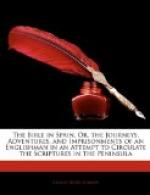“My good man,” said I, “I am invariably of the politics of the people at whose table I sit, or beneath whose roof I sleep, at least I never say anything which can lead them to suspect the contrary; by pursuing which system I have more than once escaped a bloody pillow, and having the wine I drank spiced with sublimate.”
CHAPTER XVII
Cordova—Moors of Barbary—The English—An Old Priest—The Roman Breviary—The Dovecote—The Holy Office—Judaism—Desecration of Dovecotes—The Innkeeper’s Proposal.
Little can be said with respect to the town of Cordova, which is a mean dark gloomy place, full of narrow streets and alleys, without squares or public buildings worthy of attention, save and except its far-famed cathedral; its situation, however, is beautiful and picturesque. Before it runs the Guadalquivir, which, though in this part shallow and full of sandbanks, is still a delightful stream; whilst behind it rise the steep sides of the Sierra Morena, planted up to the top with olive groves. The town or city is surrounded on all sides by lofty Moorish walls, which may measure about three quarters of a league in circumference; unlike Seville, and most other towns in Spain, it has no suburbs.
I have said that Cordova has no remarkable edifices, save its cathedral; yet this is perhaps the most extraordinary place of worship in the world. It was originally, as is well known, a mosque, built in the brightest days of Arabian dominion in Spain; in shape it was quadrangular, with a low roof, supported by an infinity of small and delicately rounded marble pillars, many of which still remain, and present at first sight the appearance of a marble grove; the greater part, however, were removed when the Christians, after the expulsion of the Moslems, essayed to convert the mosque into a cathedral, which they effected in part by the erection of a dome, and by clearing an open space for a choir. As it at present exists, the temple appears to belong partly to Mahomet, and partly to the Nazarene; and though this jumbling together of massive Gothic architecture with the light and delicate style of the Arabians produces an effect somewhat bizarre, it still remains a magnificent and glorious edifice, and well calculated to excite feelings of awe and veneration within the bosoms of those who enter it.




